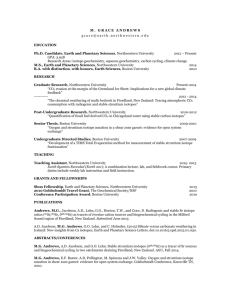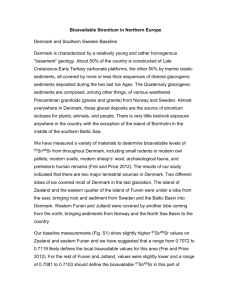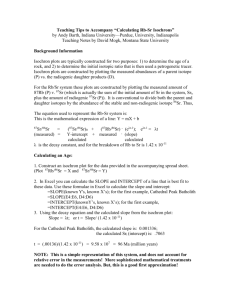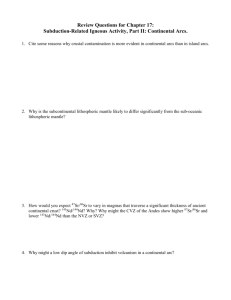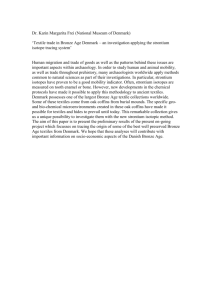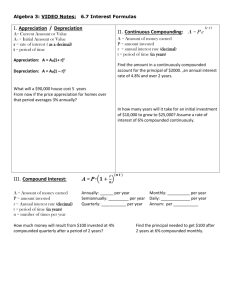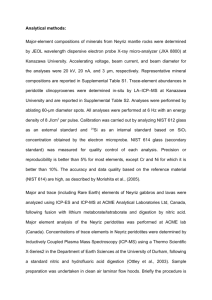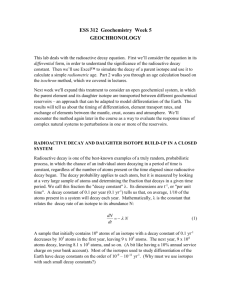The application of strontium isotope analysis to historic
advertisement
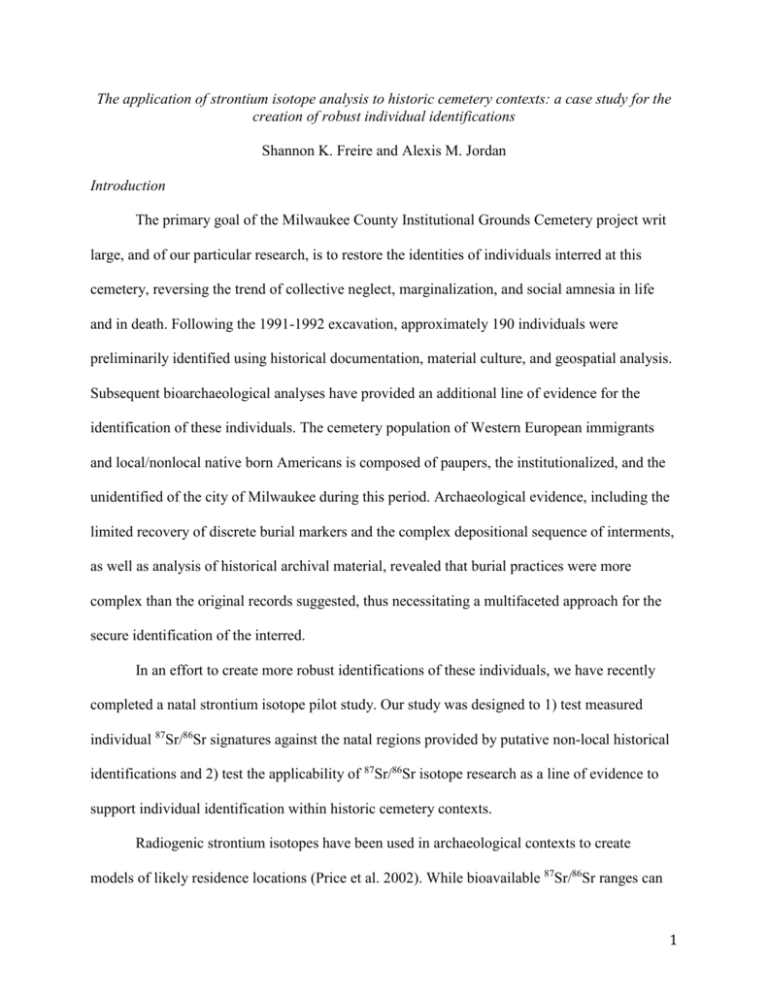
The application of strontium isotope analysis to historic cemetery contexts: a case study for the creation of robust individual identifications Shannon K. Freire and Alexis M. Jordan Introduction The primary goal of the Milwaukee County Institutional Grounds Cemetery project writ large, and of our particular research, is to restore the identities of individuals interred at this cemetery, reversing the trend of collective neglect, marginalization, and social amnesia in life and in death. Following the 1991-1992 excavation, approximately 190 individuals were preliminarily identified using historical documentation, material culture, and geospatial analysis. Subsequent bioarchaeological analyses have provided an additional line of evidence for the identification of these individuals. The cemetery population of Western European immigrants and local/nonlocal native born Americans is composed of paupers, the institutionalized, and the unidentified of the city of Milwaukee during this period. Archaeological evidence, including the limited recovery of discrete burial markers and the complex depositional sequence of interments, as well as analysis of historical archival material, revealed that burial practices were more complex than the original records suggested, thus necessitating a multifaceted approach for the secure identification of the interred. In an effort to create more robust identifications of these individuals, we have recently completed a natal strontium isotope pilot study. Our study was designed to 1) test measured individual 87Sr/86Sr signatures against the natal regions provided by putative non-local historical identifications and 2) test the applicability of 87Sr/86Sr isotope research as a line of evidence to support individual identification within historic cemetery contexts. Radiogenic strontium isotopes have been used in archaeological contexts to create models of likely residence locations (Price et al. 2002). While bioavailable 87Sr/86Sr ranges can 1 be extremely specific for a given geographical locale, strontium signatures should not intellectually be construed as having the ability to provide a ‘post-code’ of residence (Bentley 2012:9328; Pollard 2011). Rather, the use of radiogenic strontium isotope analysis is most useful when differentiating between local and non-local populations (Hedman et al. 2009; Slater et al. 2014). Within our project, strontium isotope analysis was applied by comparing dental enamel 87 Sr/86Sr signatures of preliminarily identified individuals with geologies of their historically defined natal regions. As strontium isotopes vary with types of bedrock and sediment, it has been possible to isolate geological regions within these historic countries as locations of likely origin (Price et al. 2004). Background The area of the cemetery that is the focus of our research, Area II, was in use between 1918-1925, and was excavated between 1991-1992 following the onset of construction at the Milwaukee Medical Grounds Complex in Wauwatosa, Wisconsin (Richards 1997). Preliminary historical identifications have been established with caveats and various levels of strength based on the types and efficacy of various lines of evidence drawn from osteological data, historical documentation, material culture, and excavation data. The nuance of our case study is different from most previous strontium isotope studies in that a component of our hypothesis is the expectation that all of our individuals sampled, and the majority of individuals from the MCIG cemetery, will have natal regions outside Southeast Wisconsin (Richards 1997:126; Schwarcz et al. 2010:345). For all individuals in this study the historical information and osteological analysis were in agreement. We cannot preferentially favor determined 87Sr/86Sr signatures that suggest an area of geological origin different from the historically provided natal region if we do not have a 2 reason to dismiss the historical identification out of hand. Each of these lines of evidence must be characterized as working in tandem, and providing give-and-take as we conduct our analysis. Strontium Isotope Analysis There are four naturally occurring isotopes of Strontium and our attention focuses specifically on the single radiogenic isotope, 87Sr. The abundance of radiogenic 87Sr is expressed as a ratio relative to the abundance of non-radiogenic 86Sr, and this ratio varies with geology, water, and bioavailability (Pye 2004:220). In the course of an animal’s regular biological activity (eating and drinking), the local isotope composition of the water, plants, and animals consumed is captured in its skeletal tissues when strontium substitutes for calcium during element mineralization (Slater et al. 2014:118). Pye describes 87Sr/86Sr as an “ideal tracer for where an organism lived and derived the bulk of its diet” (2004:218) as there is no metabolic fractionation, or change in relative abundance, as a result of an animal’s body size, metabolic processes, or diet (Slater et al. 2014:118). Materials and Methods Of the three primary components of a human tooth, enamel is the hardest and most inorganic. By substituting for Calcium in inorganic apatite, Strontium is incorporated into human enamel (Radhakrishan 2011). The skeleton actively remodels over the course of an individual’s life, thus 87Sr/86Sr signatures from archaeological bone will reflect the last years of life history, rather than a natal region, in the case of an immigrant (Schwarcz 20010:336). The exclusive use of bone as a material for strontium isotope analysis is thus dependent on the nature of the research question and comes with additional complications and concerns with respect to diagenic contamination (Budd et al. 2000; Lee-Thorp 2008; Price 2007). When compared with bone or dentine, the greater bond strength of enamel makes it an ideal material for isotope analysis, as it 3 is less prone to environmental exchange and post-depositional diagenesis (Pye 2004). By incorporating the permanent M1 and M3 molars, an environmental picture encapsulating the first few months before birth through approximately 15 years of age is created (Hillson 1996; Pye 2004; White and Folkens 2005). The additional use of the permanent third molar enables the consideration of two important factors; 1) the possibility of early childhood migration, or migration of the mother, in that 2) the first permanent molar, because of pre-natal and early life mineralization, will receive strontium input from the mother through pregnancy diet and lactation (Dupras and Tocheri 2007; Schwarcz et al 2010:336). A total of 18 human teeth from 9 individuals from the 1991-1992 MCIG collection representing 9 distinct mortuary contexts were analyzed for 87Sr/86Sr isotope ratios. The sample was obtained from the tooth enamel of select individuals with robust preliminary historic identifications, congruent osteological profiles, and first and third permanent molars in good condition. These molars were analyzed for each individual, allowing us to highlight any differences in 87Sr/86Sr isotope ratios. Biological profiles were completed according to standard osteological methods (Buikstra and Ubelacker 1994; Spradley and Jantz 2011; White, Black and Folkens 2012). Sample preparation was undertaken following the procedures outlined in Hedman et al. 2009 and Slater et al. 2014. Mass spectrometry was performed using a Nu Plasma HR multicollector ICP-mass spectrometer at the University of Illinois Champaign-Urbana. Results Like strontium’s bioavailability, finding a match in natal regions is an organic process, complicated by differing availability of geological surveys, hydrological surveys, and archaeological strontium isotope studies. We determined whether each individual’s strontium signatures fell within published bioavailable ranges of their putative natal regions, based on 4 geological bedrock and sediment, water, fauna, and human dental enamel. Together, these factors comprise an isoscape of a geographic region. We isolated 87Sr/86Sr isoscapes in each historically identified region that matched the individuals’ natal 87Sr/86Sr signatures. For the purposes of our discussion, we will be referring to our putatively identified individuals by name in keeping with our intent to restore identity, while acknowledging that these identifications, while robust, are in still in development. Our profile identifications fell into three categories. Frequently, it was the case that we were able to pinpoint geologic formations that would generate a 87Sr/86Sr range similar to that which was determined via MC-ICP-MS, but we were not able to definitely preference one region of a nation over another; for example, central over southwest Germany in the case of contiguous geologic formations between these regions. This is illustrated by two individuals, Emil Richardt and Ernst Gutzhke, both with natal German regions and relatively more radiogenic 87Sr/86Sr signatures. These signatures correspond with Triassic age geological formations, such as Keuper and Bundsandstein, which are found extending from southwest Germany through east-central Germany. This is contrasted with our other putatively German individual, Gustav Neumann, who has a less radiogenic 87Sr/86Sr signature that fits distinctly with the younger loess soils that are specifically seen in Pre-Alpine lowlands of Southeastern Germany. The 87Sr/86Sr signatures of Ernst Gutzhke necessitate further elaboration. The signatures of his permanent M1 and M3 differ by 0.001, a difference that has been cited in the literature as indicating potential migration (Price et al. 2004). This difference can mean one of two things: either Ernst himself migrated in childhood (5.5 months to 16 years) before the complete mineralization of his third molar, or Ernst’s mother migrated while pregnant or in the preweaning period. Given our knowledge that Ernst immigrated to the U.S. at age 22, this migration 5 was likely within Germany from a more radiogenic location to the lowlands (Drew 2015, personal communication). Conversely, we were able to positively rule out regions that would have produced 87 Sr/86Sr ranges that were either too high or too low based on their geology, hydrology, and overall bioavailable strontium levels. The 87Sr/86Sr signature of Harry Newton fits within a very specific region of Ohio, the Scioto River watershed, located on Silurian-aged bedrock. The 87 Sr/86Sr signature of Gertrude West fits within a specific area of Indiana in the Southwest characterized by Pennsylvanian-aged bedrock. It should be noted that the human dental enamel comparison used to identify this isoscape was derived from a match in neighboring Illinois with comparable geologies, as no human enamel strontium studies have been published for this area of Indiana. The identification of areas of matching bioavailable 87Sr/86Sr within Poland was fairly straightforward; Poland can essentially be characterized as having a relatively homogenous and less radiogenic area to the north and a geologically heterogeneous and more radiogenic area in the south. Identified individuals Bruno Barkovich and John Zinich can both be associated with the area of northern Poland characterized by young Cenozoic bedrock overlain with coversands, loess, and gravel. Because geological formations frequently appear across national boundaries and political boundaries are dynamic, extra care must be taken in the case of individuals from regions characterized by historically shifting political boundaries. Two individuals provide specific examples of this concern. Vasila Abrodavich died in 1924. His natal region was listed as Czechoslovakia, which was not an extant political unit until 1918 (Briggs and Clavin 2003). At the time of his dental mineralization, his matching isotopic region would have been part of Austro-Hungarian Empire. Wolfgang Aschenbrenner also presents a complex case. His natal 6 region is listed as Austria/Hungary. Our first step was to eliminate Hungary, based on the relatively less radiogenic bioavailable 87Sr/86Sr ranges seen in the homogenous geology. Aschenbrenner’s relatively high 87Sr/86Sr values match well with the metamorphic bedrock overlain with loess sediments of Weinviertel region of lower Austria. However, his 87Sr/86Sr signatures also match ranges seen within the Czech Republic, in an area north of the Elbe with a similar geological profile. Given that there was no discernable standardization in the assignment of natal regions in our historical records with respect to then current political boundaries and despite linguistic affiliation of individual names with each of the natal regions provided, these individuals may have grown up in an area of matching geology but differing political designation than the stated burial record entry. Discussion There are several research questions this case study contributes to and suggests areas for further investigation. First, it was our intention to establish the utility of 87Sr/86Sr analysis in later historical contexts. This is a relatively under-researched time period, and is accompanied by additional unique complications that are not generally a consideration in prehistoric isotopic studies. First, there is the issue of a more ‘cosmopolitan’ diet as a result of changing availability of dietary sources through transportation and agrarian practices associated with industrialization (Keita et al. 2010). The companion concern to the ‘cosmopolitan’ diet is the greater utilization of water reservoirs and deep wells in conjunction with public health concerns in the face of burgeoning populations and industrial pollution (Leavitt 1997). While refrigerated train cars are not an explicit concern for our population at this time, general concerns regarding the urbanization of diet can be mitigated by providing more generalized localities for natal origin as we have done in this study. Exploration into the influence of aquifer geologies through the 7 introduction of well water to the diet can be explored in Southeast Wisconsin, as well water has an appreciably lower 87Sr/86Sr range than surface water, which brings us to areas for future research. One element of our planned future research is the addition of an increased level of specificity in our identification of natal regions through 18O analysis. When strontium research is complemented by oxygen isotope analysis, the clinal variations created by precipitation narrow the ranges of the geologic natal regions identified with 87Sr/86Sr ratios. Generation of a more specific geographic profile will in turn allow us to incorporate additional localized historical documentation. This will aid in strengthening preliminary identifications of these individuals and contribute to our understanding of population demographics and immigrant populations in turnof-the-century Southeast Wisconsin. It also highlights a second area for further research, the creation of a viable isotopic study model for future immigrant cemetery analyses in Southeast Wisconsin. In the future, this can be accomplished by testing the first and third permanent molars of definitively local individuals in order to establish a bioavailable 87Sr/86Sr range for this historic time period in Southeast Wisconsin. Lastly, in an effort to continue our stated (research) goal of providing an additional line of evidence through isotopic analysis for generating robust individual identifications, we cannot state strongly enough the importance of receiving curational responsibility for the individuals recovered during the 2013 excavation, to continue this important work of restoring names and identities to the individuals that were interred at the Milwaukee County Institutional Grounds Poor Farm Cemetery. Thank you. 8 References (For text and PowerPoint) Asch, K. 2005 The 1:5 Million International Geological Map of Europe and Adjacent Areas. BGR, Hannover. Bataille, Clément P. and Gabriel J. Bowen 2012 Mapping 87Sr/86Sr variations in bedrock and water for large scale provenance studies. Chemical Geology 304-305:39-52. Beard, B.L. and C.M. Johnson 2000 Strontium isotope composition of skeletal material can determine the birth place and geographic mobility of humans and animals. Journal of Forensic Sciences 45(5):1049-1061. Beehr, Dana Elizabeth 2011 Investigation of Middle Woodland Population Movement in the Midwestern United States Using Strontium Isotopes, Anthropology, University of Illinois at UrbanaChampaign, Urbana, Illinois. Bentley, R. Alexander 2006 Strontium Isotopes from the Earth to the Archaeological Skeleton: A Review. Journal of Archaeological Method and Theory 13(3):135-187. Bentley, R. Alexander , Penny Bickle, Linda Fibiger, Geoff M. Nowell, Christopher W. Dale, Robert E. M. Hedges, Julie Hamilton, Joachim Wahl, Michael Francken, Gisela Grupeg, Eva Lenneish, Maria Teschler-Nicolah, Rose-Marie Arbogast, Daniela Hofmann and Alasdair Whittle 2012 Community differentiation and kinship among Europe’s first farmers. Proceedings of the National Academy of Sciences 109(24):9326-9330. Bentley, R. Alexander, T. Douglas Price, Jens Lüning, Detlef Gronenborn, Joachim Wahl and Paul D. Fullager 2002 Prehistoric migration in Europe: Strontium Isotope Analysis of Early Neolithic Skeletons. Current Anthropology 43(5):799-804. Budd, Paul, Janet Montgomery, Barbara Barreiro and Richard G. Thomas 2000 Di€ fferential diagenesis of strontium in archaeological human dental tissues. Applied Geochemistry 15:687-694. Buikstra, Jane E. and Douglas H. Ubelaker 1994 Standards For Data Collections from Human Skeletal Remains. Arkansas Archaeological Survey Research Series No. 44, Fayetteville, AK. Curtis, John B., Jr. and Alan M. Stueber 9 1973 Sr/Sr Ratios and Total Strontium Concentrations in Surface Waters of the Scioto River Drainage Basin, Ohio. Ohio Journal of Science 73(3):166-175. Daniels, Michael Ian Storm 2011 Bedrock Geology of Indiana. vol. 2015. Indiana Geological Survey. Drew, Brooke L. 2013 Bioarchaeological and Archival Investigations of the Milwaukee County Institution Grounds Cemetery Collection: A Progress Report. Paper presented at the 2013 meetings of the Society for Historical Archaeology, Leicester, UK. 2015 Personal Communication. Gradstein, Felix M., James G. Ogg, Mark D. Schmitz and Gabi M. Ogg 2012 The Geologic Time Scale Volume 2. Elsevier, New York. Gregoricka, L. A., T. K. Betsinger, A. B. Scott and M. Polcyn 2014 Apotropaic practices and the undead: a biogeochemical assessment of deviant burials in post-medieval poland. PLoS One 9(11):1-24. Grumbkow, Philipp v, Sören Frommer, Lisette M. Kootker, Gareth R. Davies, Janine Mazanec and Susanne Hummel 2013 Kinship and mobility in 11th-century A.D. Gammertingen, Germany: an interdisciplinary approach. Journal of Archaeological Science 40(10):3768-3776. Gulbranson, Erik 2015 Personal Communication. Hedman, Kristin M., B. Brandon Curry, Thomas M. Johnson, Paul D. Fullagar and Thomas E. Emerson 2009 Variation in strontium isotope ratios of archaeological fauna in the Midwestern United States: a preliminary study. Journal of Archaeological Science 36:64-73. Hillson, S. 1996 Dental Anthropology. Cambridge University Press, Cambridge. Knipper, Corina, Anne-France Maurer, Daniel Peters, Christian Meyer, Michael Brauns, Stephen J.G. Galer, Uta von Freeden, Bernd Schöne, Harald Meller and Kurt W. Alt 2012 Mobility in Thuringia or mobile Thuringians: A strontium isotope study from early medieval Central Germany. In Population dynamics in pre- and early history: new approaches by using stable isotopes and genetics, edited by J. Burger, E. Kaiser and W. Schier, pp. 287-310. De Gruyter Inc., Berlin. Kolata, Dennis R., F. Brett Denny, Joseph A. Devera, Ardith K. Hansel, Russell J. Jacobson, Zakaria Lasemi, Christopher S. McGarry, W. John Nelson, Rodney D. Norby, Colin G. Treworgy, C. Pius Weibel, Curtis C. Abert, Scott Medlin and Barbara J. Stiff 10 2005 Bedrock Geology of Illinois, edited by I. S. G. Survey, pp. Illinois Map 14. Lee-Thorp, J. A. 2008 On Isotopes and Old Bones. Archaeometry 50(6):925-950. McArthur, J.M., R.J. Howarth and T.R. Bailey 2001 Strontium Isotope Stratigraphy: LOWESS Version 3: Best Fit to the Marine Srisotope Curve for 0-509 Ma and Accompanying Look-Up Table for Deriving Numerical Age. The Journal of Geology 109:155-170. McArthur, J.M., R.J. Howarth and G.A. Shields 2012 Strontium Isotope Stratigraphy. In The Geologic Time Scale 2012, edited by F. M. Gradstein, J. G. Ogg, M. D. Schmitz and G. M. Ogg, pp. 127-144. vol. 1. Elsevier, Oxford. Montgomery, Janet 2010 Passports from the past: Investigating human dispersals using strontium isotope analysis of tooth enamel. Annals of Human Biology 37(3):325–346. Oelze, V. M., O. Nehlich and M. P. Richards 2012 ‘There's No Place Like Home’-No Isotopic Evidence for Mobility at the Early Bronze Age Cemetery of Singen, Germany. Archaeometry 54(4):752-778. Oelze, V. M., Julia K. Koch, Katharina Kupke, Olaf Nehlich, Steve Zäuner, Joachim Wahl, Stephan M. Weise, Sabine Rieckhoff, and Michael P. Richards 2012 Multi-Isotopic Analysis Reveals Individual Mobility and Diet at the Early Iron Age Monumental Tumulus of Magdalenenberg, Germany. American Journal of Physical Anthropology 148:406-421. Price, Douglas T., James H. Burton and James B. Stoltman 2007 Place of Origin of Prehistoric Inhabitants of Aztalan, Jeffereson Co., Wisconsin. American Antiquity 72(3):524-538. Price, T. Douglas, Corina Knipper, Gisela Grupe and Václav Smrcka 2004 Strontium Isotopes and Prehistoric Human Migration: The Bell Beaker Period in Central Europe. European Journal of Archaeology 7(1):9-40. Price, T. Douglas, J. Wahl, C. Knipper and E. Burger-Heinri 2003 Untersuchungsergebnisse zum Migrationsverhalten im frühen Neolithikum. Fundberichte aus Baden-Württemberg 27:23-58. Price, T. Douglas, Joachim Wahl and R. Alexander Bentley 2006 Isotopic Evidence for Mobility and Group Organization Among Neolithic Farmers at Talheim, Germany, 5000 BC. European Journal of Archaeology 9(2-3):259284. 11 Price, T.D., J.H. Burton and R.A. Bentley 2002 The Characterization of Biologically Available Strontium Isotope Ratios for the Study of Prehistoric Migration. Archaeometry 44(1):117-135. Pye, Kenneth 2004 Isotope and trace element analysis of human teeth and bones for forensic purposes. In ForensicGeoscience:Principles,TechniquesandApplications, edited by K. Pye and D. J. Croft, pp. 215-236. vol. 232. Geological Society, Special Publications, London. Radhakrishnan, Raghu 2011 Chewing the very teeth because it bites: An anthropological forensics by stable isotope profiling. Journal of Forensic Dental Science 3(1):1-2. Richards, Michael Phillip, Janet Montgomery, Olaf Nehlich and Vaughan Grimes 2008 Isotopic analysis of humans and animals from Vedrovice. Anthropologie 46(23):185-194. Richards, Patricia B. 1997 Unknown Man No. 198 - The Archaeology of the Milwaukee County Poor Farm Cemetery. Dissertation, Ph.D. dissertation, Department of Anthropology, University of Wisconsin-Milwaukee, Milwaukee. Richards, Patricia B. and Matthias Kastell 1993 Archaeological Excavations at the Almshouse Burial Ground Milwaukee County Poorhouse, Wauwatosa, Wisconsin. Great Lakes Archaeological Research Center, Inc. Scheeres, M., C. Knipper, M. Hauschild, M. Schonfelder, W. Siebel, C. Pare and K. W. Alt 2014 "Celtic migrations": fact or fiction? Strontium and oxygen isotope analysis of the Czech cemeteries of Radovesice and Kutna Hora in Bohemia. American Journal of Physical Anthropology 155(4):496-512. Schwarcz, Henry P., Christine D. White and Fred J. Longstaffe 2010 Stable and Radiogenic Isotopes in Biological Archaeology: Some Applications. In Isoscapes: understanding movement, pattern, and process on earth through isotope mapping, edited by J. B. West, G. J. Bowen, T. E. Dawson and K. P. Tu, pp. 335-356. Springer, New York. Slater, Philip A. , Kristin M. Hedman and Thomas E. Emerson 2014 Immigrants at the Mississippian polity of Cahokia: strontium isotope evidence for population movement. Journal of Archaeological Science 44:117-127. Smrčka, Václav, František Bůzek, Vojtěch Erban, Tomáš Berkovec, Marta Dočkalová, Kateřina Neumanová and Miriam Nývltová Fišáková 2005 Carbon, Nitrogen and Strontium isotopes in the set of skeletons from the Neolithic settlement at Vedrovice. Anthropologie 43(2-3):315-323. 12 Stueber, A. M. , P. Pushkar and E. A. Hetherington 1987 A Strontium Isotopic Study of Formation Waters from the Illinois Basin, U.S.A. . Applied Geochemistry 2:477-494. Stueber, Alan M., Paul Pushkar and A. Dwight Baldwin Jr. 1972 Survey of 87Sr/86Sr Ratios and Total Strontium Concentrations in Ohio Stream and Ground Waters. Ohio Journal of Science 72(2):97-104. Survey, Ohio Division of Geological 2006 Bedrock geologic map of Ohio: Ohio Department of Natural Resources, Division of Geological Survey Map BG-1, pp. generalized page-size version with text, 2p., scale 1:2,000,000. Theiner, Sarah 2011 The use of strontium isotope ratio measurements by MC-ICP-MS for fundamental studies on diagenesis and for the reconstruction of animal migration at the Celtic excavation site Roseldorf, Ph.D. dissertation, Magistra der Naturwissenschaften, Universität Wien, Vienna. Voerkelius, Susanne, Gesine D. Lorenz, Susanne Rummel, Christophe R. Quétel, Gerhard Heiss, Malcolm Baxter, Christophe Brach-Papa, Peter Deters-Itzelsberger, Stefan Hoelzl, Jurian Hoogewerff, Emmanuel Ponzevera, Marleen Van Bocxstaele and Henriette Ueckermann 2010 Strontium isotopic signatures of natural mineral waters, the reference to a simple geological map and its potential for authentication of food. Food Chemistry 118(4):933940. White, Tim D., Michael T. Black and Pieter A. Folkens 2011 Human Osteology. Third ed. Elsevier Academic Press, London. White, Tim D. and Pieter A. Folkens 2005 The Human Bone Manual. Elsevier Academic Press, Burlington. Wisconsin Geological and Natural History Survey 2005 Bedrock Geology of Wisconsin. Wisconsin Geological and Natural History Survey, University of Wisconsin-Extension. 13
